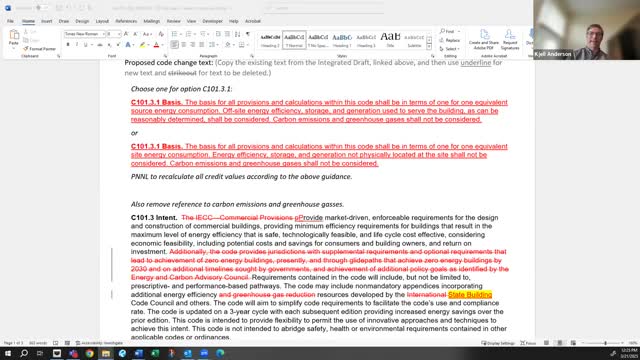Washington Council examines complexities of carbon emissions standards for energy codes
March 23, 2025 | Building Code Council, Governor's Office - Boards & Commissions, Executive, Washington
This article was created by AI summarizing key points discussed. AI makes mistakes, so for full details and context, please refer to the video of the full meeting. Please report any errors so we can fix them. Report an error »

In a recent meeting of the Building Code Council held on March 21, 2025, members engaged in a robust discussion about the complexities of carbon emissions factors and energy codes in Washington State. The atmosphere was charged with a sense of urgency as council members reflected on the evolution of energy codes and the pressing need for clarity in how carbon emissions are calculated.
Kjell, a council member, opened the dialogue by recalling his first meeting, where the carbon emissions table was a contentious topic. He expressed skepticism about the reliability of existing carbon emissions factors, noting that they can vary significantly based on time and conditions. "There’s a huge amount of complexity in getting source factors," he stated, emphasizing that any future building codes must consider the electricity mix of the future, not just the present. This forward-looking approach is crucial as buildings constructed under the new codes will have lifespans extending into the next century.
Damon, another council member, reminisced about the simplicity of the 2006 energy code, which primarily focused on building envelopes rather than the intricacies of energy efficiency. He pointed out that the shift towards considering site versus source energy began with the 2006 code, highlighting the ongoing evolution of energy standards in response to changing energy landscapes.
Angela added to the conversation by suggesting that a complete overhaul of the current code to focus on source energy could lead to a surge in new proposals. "We would need to get a whole new batch of proposals if we were to take this direction," she noted, indicating the potential for a significant shift in how energy efficiency is approached.
The council also discussed the implications of these changes on existing petitions and the potential need for additional hearings to address the complexities of source energy factors. Kjell suggested that while a new proposal window might not be necessary, the work involved in recalibrating energy models to align with new source factors would be extensive.
As the meeting progressed, the council members acknowledged the broader context of their discussions, recognizing that the decisions made today would impact energy efficiency standards for years to come. The dialogue underscored the delicate balance between innovation and practicality in crafting building codes that not only meet current needs but also anticipate future energy demands.
In conclusion, the Building Code Council's meeting highlighted the intricate challenges of updating energy codes in Washington State. As they navigate the complexities of carbon emissions and energy efficiency, the council remains committed to ensuring that future building practices align with the state's decarbonization goals. The discussions reflect a critical moment in shaping the future of energy use in Washington, with implications that extend far beyond the walls of city hall.
Kjell, a council member, opened the dialogue by recalling his first meeting, where the carbon emissions table was a contentious topic. He expressed skepticism about the reliability of existing carbon emissions factors, noting that they can vary significantly based on time and conditions. "There’s a huge amount of complexity in getting source factors," he stated, emphasizing that any future building codes must consider the electricity mix of the future, not just the present. This forward-looking approach is crucial as buildings constructed under the new codes will have lifespans extending into the next century.
Damon, another council member, reminisced about the simplicity of the 2006 energy code, which primarily focused on building envelopes rather than the intricacies of energy efficiency. He pointed out that the shift towards considering site versus source energy began with the 2006 code, highlighting the ongoing evolution of energy standards in response to changing energy landscapes.
Angela added to the conversation by suggesting that a complete overhaul of the current code to focus on source energy could lead to a surge in new proposals. "We would need to get a whole new batch of proposals if we were to take this direction," she noted, indicating the potential for a significant shift in how energy efficiency is approached.
The council also discussed the implications of these changes on existing petitions and the potential need for additional hearings to address the complexities of source energy factors. Kjell suggested that while a new proposal window might not be necessary, the work involved in recalibrating energy models to align with new source factors would be extensive.
As the meeting progressed, the council members acknowledged the broader context of their discussions, recognizing that the decisions made today would impact energy efficiency standards for years to come. The dialogue underscored the delicate balance between innovation and practicality in crafting building codes that not only meet current needs but also anticipate future energy demands.
In conclusion, the Building Code Council's meeting highlighted the intricate challenges of updating energy codes in Washington State. As they navigate the complexities of carbon emissions and energy efficiency, the council remains committed to ensuring that future building practices align with the state's decarbonization goals. The discussions reflect a critical moment in shaping the future of energy use in Washington, with implications that extend far beyond the walls of city hall.
View full meeting
This article is based on a recent meeting—watch the full video and explore the complete transcript for deeper insights into the discussion.
View full meeting
